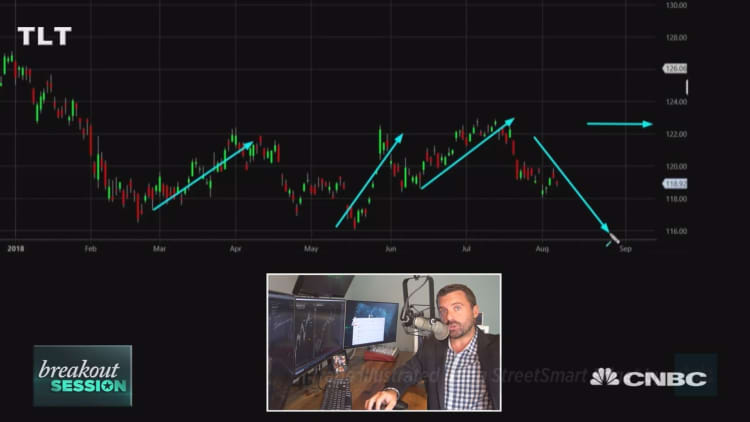The U.S. government auctions $26 billion in new 10-year Treasury notes Wednesday, usually a routine affair, but more interesting this month because the offering is a record size and it could bring a 3 percent yield at auction for the first time in 7 years.
Investors sold the 10-year note Tuesday, ahead of the auction, driving the yields higher and making it potentially more attractive to buyers. The 10-year is a key benchmark, and it impacts interest rates on mortgages and a range of consumer and business loans. It was yielding 2.976 percent Tuesday afternoon.
Faced with $22 trillion in debt, the Treasury last week expanded the size of its quarterly refunding by $30 billion to meet its expanding obligations due to the impact of tax reform and fiscal spending programs. The 10-year auction will be $1 billion larger Wednesday and in each of the next two months as a result.
"May, 2011 was the last time we had a coupon at 3 percent or higher, just before the U.S. was downgraded," said George Goncalves, head of U.S. rates strategy at Nomura.

The 10-year auction, Wednesday at 1 p.m. ET, comes on the heels of a slightly soft $34 billion 3-year auction Tuesday and ahead of Thursday's auction of $18 billion in 30-year bonds. Traders consider a 3 percent yield a real possibility, since the refunding is a new issue and there is CPI inflation data Friday, which could send yields higher if it's hotter than expected.
The miss in the July jobs report last Friday has been a counterweight on yields, since there was no wage pressure and it showed only 153,000 jobs created, compared to 195,000 that were expected. The 10-year yield also tracked the German bund yield lower this week, which moved down on weaker German data.
"We're at record sized auctions and at several key benchmarks, but the late cycle growth concerns both domestically and globally have become more topical than financing tax reform with Treasurys. The last time we reached north of 3 percent was at the August FOMC and before that was the June FOMC meeting," said Ian Lyngen, head of rate strategy at BMO.
The debate in the bond market focuses on whether the 10-year yield, which briefly traded above 3 percent in the cash market last week, will continue to drift below that psychological level or return there and hold above it. For one, bond yields, which move opposite price, typically drift lower in August.
Another concern is that perhaps heavier-than-usual pension buying, which has been driving longer-end rates lower lately, may be about to slow down.
"A lot of U.S. corporations get to deduct pension contributions at old tax rates which are high. They get a pretty hefty deduction, but that goes away in September and we think they've been front-loading their bond purchases," said Michael Schumacher, director of strategy at Wells Fargo. When those purchases end, a significant group of buyers will be out of the market and that could push bond yields higher.
"Fourteen of the last 20 years have seen a rally in the bond market in August," said Goncalves. Goncalves said the August seasonal factors have been powerful drivers of rates, but in three of the last five years, rates have actually moved higher. In 2013, the market was focused on the Fed tapering its bond buying program, and yields shot higher in a "taper tantrum." In 2015, U.S. yields moved higher ultimately in reaction to China's currency devaluation, and in 2016, the market was responding to the aftermath of moves related to Brexit.
"There are a few things that could upset this. ... If there's an escalation of the trade war the Bank of Japan is guiding rates higher," said Goncalves.
WATCH: Are Treasuries still a safe haven?



